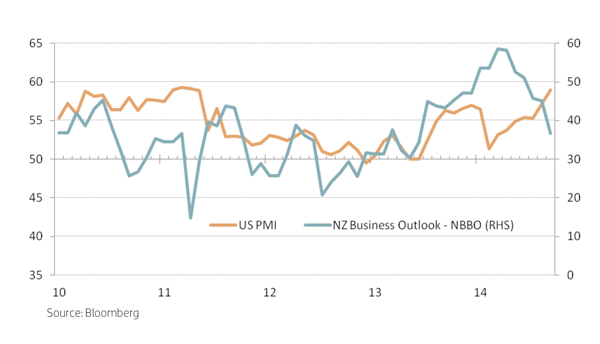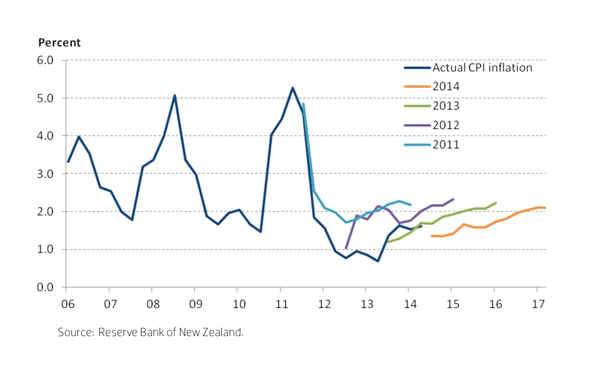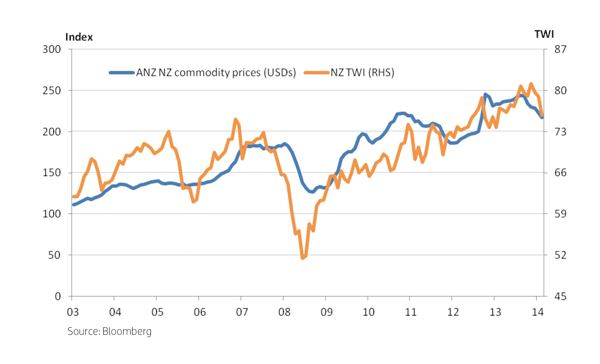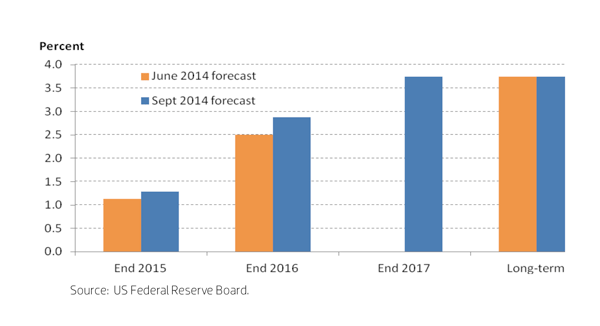Diverging cycles driving FX market
Wednesday, October 15th 2014, 8:12AM
by Harbour Asset Management
For much of 2013 and 2014, the New Zealand economy has been out of sync with the rest of the world, with New Zealand buoyed by strong commodity prices, record net migration, and the construction boom from the Canterbury rebuild.
That theme of New Zealand being out of sync has continued into the second half of 2014, but now it is a case of the path of the New Zealand economy moderating, while the United States economy gathers speed out of its post GFC recovery. These diverging cycles were the main underlying drivers of a re-emergence of FX volatility in September.
Chart 1. NZ business confidence vs. US Manufacturing PMI

The RBNZ signals a pause and makes a concerted effort to lower the NZ dollar
As expected, the RBNZ left the OCR unchanged at 3.50% at its September Monetary Policy Statement (MPS), reiterating the message from its July Statement that the time has come to pause and assess the impact of the increase in the OCR from 2.50%. However, the MPS did include some surprises.
First, the RBNZ revised down their forecast of 90 day bank bills 2 years ahead by around 50 basis points. After CPI inflation continually surprising on the downside in recent years, it appears that the RBNZ feels as though it has much more breathing space, and less need for an aggressive interest rate forecast. Furthermore, on further reflection, the RBNZ seem much less concerned about the recent record levels of net migration, given the disproportionate number of young workers. On the margin, these types of immigrants tend to alleviate labour supply constraints (reducing wage inflation) rather than adding to demand pressures in the housing market (feeding house price inflation).
Chart 2. The RBNZ’s CPI inflation forecasts

The second surprise within the Monetary Policy statement was the aggressive language around the currency, reiterating that the NZ dollar was excessively overvalued and prone for a hard fall. This completely removed any doubt the downward correction before the September MPS was anywhere enough in the eyes of the RBNZ. Indeed, the RBNZ backed up their fighting words in the MPS with an unscheduled speech on the currency being overvalued, and then confirmation that they had undertaken their largest FX intervention since 2007.
The net impact of the left-right-left body blow was that the NZ dollar fell from 0.8380 to 0.7770 over the course of September, putting the Kiwi 10% below its peak in July and below the RBNZ's own forecast assumption for Q4 2014. The NZ TWI is now more in line with the recent fall in NZ commodity prices - see chart. (The RBNZ's efforts were no doubt helped by a sharp rise in the US dollar, see below, but credit where it is due).
Chart 3. NZ Trade Weighted Index vs ANZ Commodity Prices

At this stage, the sharp fall in the NZ dollar has not had significant impact on NZ interest rate markets.
- At the short end of the yield curve, a sharp fall in the currency typically causes interest rates to rise, to offset the overall effect on desired monetary conditions. However, given that the RBNZ has been so vocal in deliberately driving the fall in the NZ dollar, it seems unlikely that the fall in the NZ dollar should prompt the RBNZ to quickly resume a tightening cycle. More likely, the RBNZ uses the low level of CPI inflation as breathing space to take time to assess the impact of their policy actions so far this year.
- At the long end of the yield curve, a sharp fall in the currency can cause some foreign holders of NZ government bonds to liquidate their position out of fear of incurring further FX losses. These forced sellers can push up yields on NZ government bonds. However, at this stage, there are few reports of panicked selling in the bond market - with any fast money hedge fund sellers being replaced by demand from real money investors, foreign central bank and sovereign wealth funds. We will continue to monitor intelligence on foreign demand.
US Federal Reserve signals the removal of stimulus
Since the so-called ‘taper tantrum’ in mid 2013, markets have been particularly nervous about the Quantitative Easing (QE) program being unwound and the eventual shift from very low interest rates. Having provided an unprecedented amount of stimulus to support the US economy, the Fed faces the challenge of removing policy support without rattling financial markets.
With growing confidence that the US economy has strong economic momentum, the US Fed took a step along that path with its policy statement in September.
On the one hand, the US Fed sought to reassure markets by reiterating its pledge to keep overnight interest rates low for a “considerable time” after it stops its Quantitative Easing programme (QE) in October. While they retain some wriggle room, the market has interpreted this to imply no increase in the overnight Fed Funds rate till mid 2015.
However, alongside the calming and reassuring press release, the US Fed’s own economic forecasts suggest they have growing confidence that US interest rates will be rising steadily in coming years. The Fed’s median forecast for the overnight Fed funds rate at the end of 2015 rose from 1.13% in June to 1.375%, while the 2016 median forecast rose from 2.5% to 2.875%. For the first time they released an end 2017 forecast of 3.75%, which is considerably above the equivalent interest rate futures contract trading at 2.95%.
Chart 4. FOMC median Fed Funds Forecasts

With the US interest rate market anchored by the pledge to keep overnight rates on hold for now, the main market implication of this has been strength in the US dollar, as markets look forward to the period when US interest rates are no longer so low. The US dollar has strengthened by around 10% since its lows in 2014, undoubtedly helping the cause of the RBNZ in its quest to see the NZ dollar relatively weaker.
Market outlook
At the short end of the yield curve, we continue to expect a period of near term stability.
With New Zealand economic growth moderating from a swift pace earlier in the year, and CPI inflation still well below target, we believe the RBNZ has time to reflect and observe the impact of the rise in the OCR to 3.50% and the recent fall in the NZ dollar.
While the market is currently pricing no further change in the OCR until July 2015, the RBNZ has been clear that its next steps are highly conditional. In other words, the next move in the OCR could be anywhere between December 2014 and September 2015, depending on how the economy evolved from here.
At the long end of the yield curve, we continue to see the medium-term risk skewed towards rising yields globally.
While the market is currently taking comfort from the US Federal Reserve’s pledge to keep overnight interest rates near zero into mid 2015, there is a danger that long-term interest rates start to pre-empt this move, in much the same way that the US dollar has been driven more by the signal of future policy than any immediate policy changes from the US Fed.
Long term interest rates have been held down by a collection of factors through 2014, from geopolitical risks in the Ukraine, Syria and Scotland, to macroeconomic worries about Europe and China, to concerns about wobbles in the equity markets.
All the while, through the course of Q2 2014, the US economy has continued its post GFC repair, with PMIs well into expansionary territory, most labour market indicators back to pre GFC levels, and the economy registering 4.6% annualised GDP growth. With 6 years past since the beginning of the GFC, evidence is building that the US economy can sustain itself without ultra-low long-term interest rates.
Christian Hawkesby
Director, Head of Fixed Interest & Economics
Harbour Asset Management
Important disclosure information - http://www.harbourasset.co.nz/disclaimer/
Important disclaimer information
| « China's change of tack slows global growth | North Asia and deflation » |
Special Offers
Comments from our readers
No comments yet
Sign In to add your comment
| Printable version | Email to a friend |









